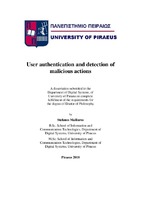Αυθεντικοποίηση χρηστών και εντοπισμός κακόβουλων ενεργειών
User authentication and detection of malicious actions

Προβολή/
Λέξεις κλειδιά
Αυθεντικοποίηση χρηστών ; Βιομετρικά χαρακτηριστικά ; Ασφάλεια χρηστών ; Κωδικοί πρόσβασης ; Authentication ; Biometric modalities ; Passwords ; User securityΠερίληψη
Οι σύγχρονες συσκευές μπορούν να πραγματοποιούν δυνητικά επικίνδυνες ενέργειες, όπως η αποθήκευση εταιρικών και προσωπικών δεδομένων, η εκτέλεση ηλεκτρονικών συναλλαγών, η πρόσβαση σε δεδομένα υγείας και πολλά άλλα. Όλες αυτές οι ενέργειες επιτρέπουν την ασφαλή πρόσβαση σε ευαίσθητες πληροφορίες, γεγονός που διεγείρει το πρόβλημα επαλήθευσης χρήστη. Η χρήση των κωδικών πρόσβασης εισάγει κρίσιμα ζητήματα ασφαλείας, ενώ η αυθεντικοποίηση δύο παραγόντων δεν είναι ανθεκτική σε επιθέσεις κακόβουλου λογισμικού.
Αυτά τα προβλήματα μπορούν να αντιμετωπιστούν μόνο με ολιστική διερεύνηση του προβλήματος της πιστοποίησης ταυτότητας χρήστη. Η ασφάλεια των online λογαριασμών επηρεάζεται δραστικά από την προβλεψιμότητα των κωδικών πρόσβασης, καθώς και από τον τρόπο αποθήκευσης τους. Ως εκ τούτου, προτείνουμε ένα μαθηματικό μοντέλο βασισμένο στις παραμέτρους που επηρεάζουν την ασφάλεια των κωδικών πρόσβασης. Ο σκοπός είναι ο υπολογισμός του κόστους επιθέσεων password guessing. Επιπλέον, πραγματοποιούμε μια ενδελεχή έρευνα των παραμέτρων προεπιλεγμένης αποθήκευσης κωδικού πρόσβασης που δείχνει ότι ένα σημαντικό ποσοστό των ιστότοπων χρησιμοποιούν μη ασφαλείς τρόπους αποθήκευσης κωδικών πρόσβασης. Έχουμε αποδείξει πως το κόστος των password guessing επιθέσεων μπορεί να είναι ένας τρόπος άμυνας απέναντι σε αυτές.
Εκτός από την αποθήκευση των κωδικών πρόσβασης, η ασφάλεια των λογαριασμών χρηστών βασίζεται στα πρωτόκολλα που χρησιμοποιούνται για τον έλεγχο ταυτότητας, καθώς και στη δυνατότητα διαρροής τους μέσω κακόβουλου λογισμικού. Επομένως, εξετάζουμε την ασφάλεια του πλαισίου ελέγχου ταυτότητας FIDO, το οποίο αντικαθιστά τους κωδικούς πρόσβασης με βιομετρικά χαρακτηριστικά. Το αποτέλεσμα της ανάλυσης είναι μια λίστα ευπαθειών που μπορεί να εκμεταλλευτεί ένας εισβολέας για να θέσει σε κίνδυνο την αυθεντικότητα, την ιδιωτικότητα, τη διαθεσιμότητα και την ακεραιότητα του FIDO. Επιπλέον, καθώς πρόσφατες έρευνες έχουν δείξει ότι τα πιστοποιητικά ελέγχου ταυτότητας και τα κρυπτογραφικά κλειδιά παραμένουν και μπορούν να διαρρεύσουν μέσω της πτητικής μνήμης, παρουσιάζουμε τεχνικές που μπορούν να εφαρμοστούν σε επίπεδο λογισμικού, είτε από το λειτουργικό σύστημα είτε από τις εφαρμογές, με σκοπό την διαγραφή των κωδικών πρόσβασης από την πτητική μνήμη.
Τέλος, με την χρήση της συνεχούς αυθεντικοποίησης, οι χρήστες επαληθεύονται συνεχώς μέσω μίας μέτρησης, η οποία μετρά τη βεβαιότητα ότι ο κάτοχος του λογαριασμού χρησιμοποιεί είτε την υπηρεσία ή την εφαρμογή. Ως εκ τούτου, προτείνουμε ένα ασφαλές σύστημα ταυτοποίησης δύο φάσεων, το οποίο εφεξής θα αναφέρετε ως gaithashing, βασισμένο στη μέθοδο βάδισης. Το προτεινόμενο σχήμα εξαλείφει το θόρυβο και τις παραμορφώσεις που προκαλούνται από διαφορετικούς τύπους σιλουέτας του χρήστη και επιτυγχάνει την εξακρίβωση της ταυτότητας του ανεξάρτητα από τη σιλουέτα του. Τέλος, αυτή η διατριβή προτείνει μια νέα τεχνική για την ανίχνευση κακόβουλων ενεργειών που βασίζεται στην μηχανική μάθηση. Αυτή εφαρμόστηκε στο πλαίσιο των δικτύων ad hoc, όπου ορίστηκε μια νέα παράμετρος, η οποία ποσοτικοποιεί τη σχέση μεταξύ των αριθμών ακολουθίας του AODV και της απόδοσης επιθέσεων τύπου blackhole.


